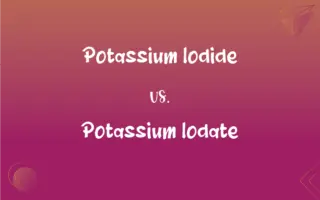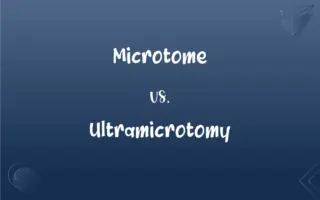Heme vs. Hemin: What's the Difference?
By Aimie Carlson & Harlon Moss || Published on October 24, 2024
Heme is an essential component of hemoglobin, aiding in oxygen transport, while hemin, its oxidized derivative, is used in labs for its crystalline form.

Key Differences
Heme plays a critical role in oxygen transport within the bloodstream, acting as a vital component of hemoglobin. Hemin, on the other hand, is an oxidized form of heme, often utilized in scientific and medical laboratories for its crystalline structure that facilitates various types of analyses.
Both heme and hemin share a similar molecular structure, with heme functioning within biological systems, particularly in proteins like hemoglobin and myoglobin. Hemin's utility in laboratories stems from its stability and solubility, characteristics that make it valuable for diagnostic purposes and research.
Heme is naturally occurring within the body, contributing to the red color of blood and essential for oxygen and carbon dioxide transport, hemin is typically synthesized or extracted for use in a controlled environment, showcasing its practical applications beyond biological functions.
Heme's significance extends to its involvement in electron transport chains, highlighting its role in cellular respiration. In contrast, hemin's properties are exploited for the crystallization of blood, aiding in the identification of blood in forensic science.
The availability of heme in the diet, particularly in meat and other animal products, underscores its nutritional value, whereas hemin, due to its specific applications, is not considered a dietary component but a biochemical tool.
ADVERTISEMENT
Comparison Chart
Definition
An iron-containing compound essential for oxygen transport in blood.
Oxidized heme used in lab settings for its crystalline form.
Role
Integral to hemoglobin and myoglobin for oxygen and CO2 transport.
Used in diagnostics, research, and forensic science.
Occurrence
Naturally in the body and dietary sources.
Synthesized or extracted for specific applications.
Applications
Biological functions like oxygen transport and electron transport.
Laboratory analyses, including blood crystallization.
Characteristics
Essential for life, involved in cellular respiration.
Stable, soluble, and valuable for its crystalline structure.
ADVERTISEMENT
Heme and Hemin Definitions
Heme
Essential for cellular respiration.
The heme group in mitochondria plays a crucial role in energy production.
Hemin
Used in medical diagnostics.
Hemin is applied in certain diagnostic procedures to detect blood disorders.
Heme
Contributes to the red color of blood.
The heme in blood gives it its characteristic red color.
Hemin
Crystalline material used in labs.
Hemin crystals are utilized to identify blood in forensic tests.
Heme
A component of hemoglobin that carries oxygen.
Heme's presence in blood cells facilitates oxygen transport from the lungs to the body.
Hemin
Oxidized form of heme.
Hemin is produced through the oxidation of heme.
Heme
Found in dietary sources like meat.
Eating red meat provides heme iron, which is readily absorbed by the body.
Hemin
Soluble and stable for research.
Its solubility makes hemin a preferred compound in biochemical research.
Heme
Involved in electron transport.
Heme is a key player in the electron transport chain, aiding in ATP synthesis.
Hemin
Not a dietary component.
Unlike heme, hemin is not found in the diet but is used in scientific studies.
Heme
A deep red, iron-containing compound, C34H32FeN4O4, that constitutes the nonprotein component of hemoglobin and certain other proteins.
Hemin
The reddish-brown crystalline chloride of heme, C34H32N4O4FeCl, produced when hemoglobin reacts with glacial acetic acid and sodium chloride in a laboratory test for the presence of blood.
Heme
(biochemistry) The component of hemoglobin (and other hemoproteins) responsible for binding oxygen. It consists of an iron ion that binds oxygen and a porphyrin ring that binds the globin molecules; one molecule binds one molecule of oxygen.
Hemin
A reddish brown substance produced in a laboratory test for the presence of blood by reaction with glacial acetic acid and sodium chloride
Heme
A complex red organic pigment containing iron and other atoms to which oxygen binds
Hemin
A substance, in the form of reddish brown, microscopic, prismatic crystals, formed from dried blood by the action of strong acetic acid and common salt; - called also Teichmann's crystals. Chemically, it is a hydrochloride of hematin.
Hemin
A reddish-brown chloride of heme; produced from hemoglobin in laboratory tests for the presence of blood
FAQs
What is hemin?
Hemin is the oxidized form of heme, used for its crystalline structure in laboratory settings.
What is heme?
Heme is an iron-containing compound in hemoglobin, crucial for oxygen transport in the blood.
How do heme and hemin differ in function?
Heme functions biologically to transport oxygen, while hemin is used in labs for analysis and diagnostics.
Is heme important for nutrition?
Yes, heme is a source of iron in the diet, especially in meat, and is important for various bodily functions.
Are heme and hemin interchangeable?
No, they serve different purposes; heme is involved in biological processes, while hemin is used for scientific research.
How is hemin used in forensic science?
Hemin crystals are used to identify and analyze blood samples in forensic investigations.
What role does heme play in the diet?
Heme contributes to the nutritional intake of iron, which is vital for oxygen transport and overall health.
Can hemin be found in the body?
Hemin is an oxidized derivative of heme and is not naturally found in the body but can be synthesized from heme.
How does the body obtain heme?
The body obtains heme through the consumption of dietary sources like meat, poultry, and fish.
Can hemin be used therapeutically?
Hemin has specific therapeutic applications, such as treating certain blood disorders by mimicking heme's function.
What distinguishes hemin's structure from heme's?
Hemin is the oxidized version of heme, making it more stable and crystalline for laboratory use.
Is there a synthetic version of heme or hemin?
Yes, synthetic versions of both compounds are produced for various applications, including dietary supplements and research.
Why is hemin valuable in research?
Its stability and solubility make hemin valuable for biochemical and medical diagnostics research.
What are the sources of heme iron in the diet?
Sources include red meats, poultry, fish, and some vegetables, though heme from animal sources is more easily absorbed.
Can hemin affect health?
While not a dietary component, hemin's use in medical treatments can indirectly benefit health by treating specific conditions.
What is the significance of heme in red blood cells?
Heme is central to hemoglobin's ability to transport oxygen and carbon dioxide, vital for respiration.
What makes heme essential for cellular respiration?
Heme plays a key role in electron transport chains, facilitating ATP synthesis and energy production.
Why is heme crucial for oxygen transport?
Heme binds to oxygen molecules in the lungs and releases them into tissues, facilitating cellular oxygenation.
How does hemin contribute to diagnostics?
Hemin's properties allow for the crystallization of blood, aiding in the diagnosis of certain conditions.
Does the body produce hemin naturally?
The body does not produce hemin; it is a laboratory-produced compound derived from the oxidation of heme.
About Author
Written by
Aimie CarlsonAimie Carlson, holding a master's degree in English literature, is a fervent English language enthusiast. She lends her writing talents to Difference Wiki, a prominent website that specializes in comparisons, offering readers insightful analyses that both captivate and inform.
Co-written by
Harlon MossHarlon is a seasoned quality moderator and accomplished content writer for Difference Wiki. An alumnus of the prestigious University of California, he earned his degree in Computer Science. Leveraging his academic background, Harlon brings a meticulous and informed perspective to his work, ensuring content accuracy and excellence.






























































